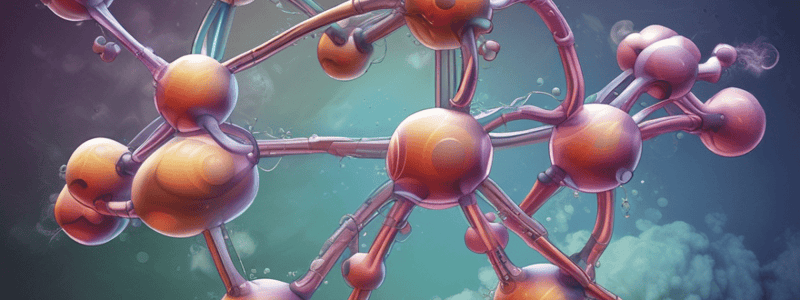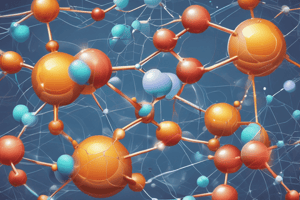Podcast
Questions and Answers
What is the primary reason for the formation of a partial positive charge on a hydrogen atom?
What is the primary reason for the formation of a partial positive charge on a hydrogen atom?
- The electronegative atom is bonded to a noble gas.
- The electronegative atom is bonded to another electronegative atom.
- The hydrogen atom is bonded to a highly electronegative atom. (correct)
- The hydrogen atom is bonded to a metal atom.
What is the typical range of bond energies for hydrogen bonds?
What is the typical range of bond energies for hydrogen bonds?
- 5-30 kJ/mol (correct)
- 1-5 kJ/mol
- 50-100 kJ/mol
- 30-50 kJ/mol
What type of hydrogen bond is formed between two separate molecules?
What type of hydrogen bond is formed between two separate molecules?
- Intramolecular hydrogen bond
- Donor hydrogen bond
- Intermolecular hydrogen bond (correct)
- Acceptor hydrogen bond
What is the primary role of hydrogen bonds in the structure of DNA?
What is the primary role of hydrogen bonds in the structure of DNA?
What is the role of hydrogen bonds in the structure of proteins?
What is the role of hydrogen bonds in the structure of proteins?
What type of hydrogen bond is classified as an electronegative atom accepting electrons?
What type of hydrogen bond is classified as an electronegative atom accepting electrons?
What is the result of the electronegative atom pulling the shared electrons in the bond closer to itself?
What is the result of the electronegative atom pulling the shared electrons in the bond closer to itself?
What is the relationship between the strength of a hydrogen bond and the distance between the atoms involved?
What is the relationship between the strength of a hydrogen bond and the distance between the atoms involved?
What percentage of atmospheric air is made up of oxygen?
What percentage of atmospheric air is made up of oxygen?
What is the primary function of oxygen in the human body?
What is the primary function of oxygen in the human body?
Which of the following is NOT a function of nutrients in the human body?
Which of the following is NOT a function of nutrients in the human body?
Where does the exchange of oxygen and carbon dioxide between the lungs and the blood take place?
Where does the exchange of oxygen and carbon dioxide between the lungs and the blood take place?
What is the main source of nitrogen for the human body?
What is the main source of nitrogen for the human body?
What is the term for the substances absorbed by the body that promote its function?
What is the term for the substances absorbed by the body that promote its function?
Which of the following is a component of a balanced diet?
Which of the following is a component of a balanced diet?
What is the main function of the respiratory system in the human body?
What is the main function of the respiratory system in the human body?
Flashcards are hidden until you start studying
Study Notes
Formation
- Hydrogen bonds are formed when a hydrogen atom bonded to a highly electronegative atom (such as oxygen, nitrogen, or fluorine) interacts with another electronegative atom.
- The electronegative atom pulls the shared electrons in the bond closer to itself, creating a partial positive charge on the hydrogen atom.
- This partial positive charge is attracted to a partial negative charge on another electronegative atom, resulting in a weak electrostatic attraction.
- Hydrogen bonds are typically formed between molecules, but can also occur within a molecule.
Strength
- Hydrogen bonds are relatively weak, with bond energies ranging from 5-30 kJ/mol.
- They are stronger than van der Waals forces, but weaker than covalent bonds.
- The strength of a hydrogen bond depends on the electronegativity of the atoms involved and the distance between them.
Types
- Intermolecular hydrogen bonds: formed between two separate molecules.
- Intramolecular hydrogen bonds: formed within a single molecule.
- Hydrogen bonds can also be classified as:
- Donor hydrogen bonds: when the hydrogen atom is bonded to an electronegative atom that donates its electrons.
- Acceptor hydrogen bonds: when the electronegative atom accepts the electrons.
Importance in DNA
- Hydrogen bonds play a crucial role in the structure and stability of DNA.
- They are responsible for holding the two strands of DNA together, forming the double helix structure.
- Hydrogen bonds between the nitrogenous bases (adenine, guanine, cytosine, and thymine) on opposite strands of DNA allow for the transmission of genetic information.
Role in Protein Structure
- Hydrogen bonds help stabilize the secondary, tertiary, and quaternary structures of proteins.
- They form between the amino acids and the surrounding solvent, as well as between different parts of the protein itself.
- Hydrogen bonds are important for maintaining the correct conformation of proteins, which is essential for their biological function.
Formation of Hydrogen Bonds
- Hydrogen bonds are formed when a hydrogen atom bonded to a highly electronegative atom (such as oxygen, nitrogen, or fluorine) interacts with another electronegative atom.
- The electronegative atom pulls the shared electrons in the bond closer to itself, creating a partial positive charge on the hydrogen atom.
- This partial positive charge is attracted to a partial negative charge on another electronegative atom, resulting in a weak electrostatic attraction.
Characteristics of Hydrogen Bonds
- Hydrogen bonds are relatively weak, with bond energies ranging from 5-30 kJ/mol.
- They are stronger than van der Waals forces, but weaker than covalent bonds.
- The strength of a hydrogen bond depends on the electronegativity of the atoms involved and the distance between them.
Types of Hydrogen Bonds
- Intermolecular hydrogen bonds: formed between two separate molecules.
- Intramolecular hydrogen bonds: formed within a single molecule.
- Hydrogen bonds can also be classified as:
- Donor hydrogen bonds: when the hydrogen atom is bonded to an electronegative atom that donates its electrons.
- Acceptor hydrogen bonds: when the electronegative atom accepts the electrons.
Importance of Hydrogen Bonds in DNA
- Hydrogen bonds play a crucial role in the structure and stability of DNA.
- They are responsible for holding the two strands of DNA together, forming the double helix structure.
- Hydrogen bonds between the nitrogenous bases (adenine, guanine, cytosine, and thymine) on opposite strands of DNA allow for the transmission of genetic information.
Role of Hydrogen Bonds in Protein Structure
- Hydrogen bonds help stabilize the secondary, tertiary, and quaternary structures of proteins.
- They form between the amino acids and the surrounding solvent, as well as between different parts of the protein itself.
- Hydrogen bonds are important for maintaining the correct conformation of proteins, which is essential for their biological function.
Intake of Raw Materials and Elimination of Waste
- The body takes in oxygen, water, and food, and excretes carbon dioxide, urine, and faeces.
Oxygen Intake
- Oxygen is a gas that makes up about 21% of atmospheric air.
- A continuous supply of oxygen is essential for human life.
- Oxygen is needed for chemical reactions that release energy from nutrients.
- The respiratory system carries air between the nose and the lungs during breathing.
- Air passes through the pharynx, larynx, trachea, bronchi, and bronchial passages, ending in alveoli.
- Alveoli are tiny air sacs in the lungs where gas exchange between the lungs and blood takes place.
Nitrogen
- Nitrogen makes up about 80% of atmospheric air but is not used by the body in its gaseous form.
- The body's nitrogen needs are met through protein-containing foods, mainly meat and fish.
Nutrition
- A balanced diet is important for health and provides nutrients.
- Nutrients include water, carbohydrates, proteins, fats, vitamins, and mineral salts.
- Nutrients are required for:
- Maintaining water balance within the body
- Energy production, mainly from carbohydrates and fats
- Synthesis of large and complex molecules, using mineral salts, proteins, fats, carbohydrates, and vitamins
- Cell building, growth, and repair, especially proteins
Digestion
- The digestive system breaks down complex food into a form the body cells can use.
- The digestive system consists of the alimentary tract and accessory glands.
- The alimentary canal is a tube that begins at the mouth and continues through the pharynx, oesophagus, stomach, small and large intestines, rectum, and anus.
- Accessory glands, including salivary glands, are situated outside the alimentary canal with ducts leading into it.
Studying That Suits You
Use AI to generate personalized quizzes and flashcards to suit your learning preferences.




